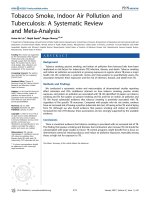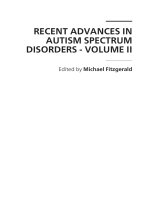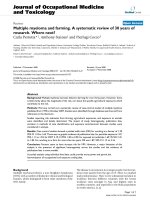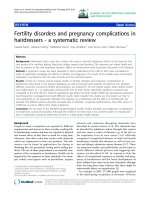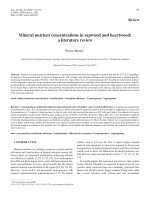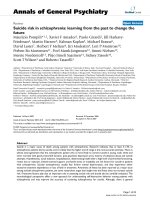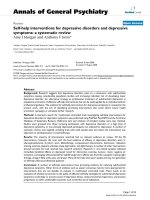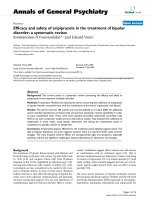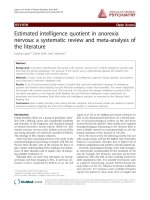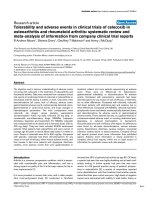Suicide prevention in schizophrenia spectrum disorders and psychosis: A systematic review
Bạn đang xem bản rút gọn của tài liệu. Xem và tải ngay bản đầy đủ của tài liệu tại đây (429.86 KB, 10 trang )
Donker et al. BMC Psychology 2013, 1:6
/>
RESEARCH ARTICLE
Open Access
Suicide prevention in schizophrenia spectrum
disorders and psychosis: a systematic review
Tara Donker1*, Alison Calear2, Janie Busby Grant3, Bregje van Spijker1, Katherine Fenton2, Kanupriya Kalia Hehir2,
Pim Cuijpers4,5 and Helen Christensen1
Abstract
Background: The incidence of suicide is high among patients with schizophrenia spectrum disorders and
psychosis. A systematic review was performed to investigate the effectiveness of psychosocial interventions in
reducing suicidal behaviour among patients with schizophrenia spectrum disorders and psychosis.
Methods: Cochrane, PubMed and PsycINFO databases were searched to January 2012. Additional materials were
obtained from reference lists. Randomised Controlled Trials describing psychosocial interventions for psychotic
disorders with attention placebo, treatment as usual (TAU), no intervention or waitlist control groups were included.
Results: In total, 11,521 abstracts were identified. Of those, 10 papers describing 11 trials targeting psychosocial
interventions for reducing suicidal behaviour in patients with schizophrenia spectrum disorders and psychosic
symptoms or disorders met the inclusion criteria. Odds Ratios describing the likelihood of a reduction in suicidal
behaviour or ideation ranged from 0.09 to 1.72 at post-test and 0.13 to 1.48 at follow-up.
Conclusions: Psychosocial interventions may be effective in reducing suicidal behaviour in patients with
schizophrenia spectrum disorders and psychosis, although the additional benefit of these interventions above that
contributed by a control condition or treatment-as-usual is not clear.
Keywords: Suicidal behaviour, Suicide, Psychosocial treatments, Psychotic disorders, Prevention
Background
Suicide risk is greatly increased in schizophrenia (Hawton
et al. 2005) and is, in particular amongst males, the leading
cause of premature death (Ösby et al. 2000; De Leo &
Spathonis 2003). It is associated with personal and family
tragedy. Suicide rates are estimated to be ten to twelve
times higher than among the average population (Carlborg
et al. 2010; Hassan-Ohayom et al. 2008), with as many as
half of all patients with schizophrenia reporting a history
of attempts (Breier et al. 1991; Harkavy-Friedman et al.
1999). Between 4 to 5% of patients complete suicide
(Carlborg et al. 2010; Hor & Taylor 2010). Risk factors for suicide in this population group include previous attempts, being male, experiencing co-morbid Post
Traumatic Stress Disorder (PTSD), and recent hospital
discharge without treatment planning (Carlborg et al.
* Correspondence:
1
Black Dog Institute, University of New South Wales Hospital Road, Prince of
Wales Hospital, Randwick, Sydney NSW 2031, Australia
Full list of author information is available at the end of the article
2010; Kasckow et al. 2011; Meltzer 2006; Tarrier & Picken
2011; Palmer et al. 2005). The risk of suicide in patients
with schizophrenia is considered to be higher in the early
course of the illness, especially within the first year
(De Leo & Spathonis 2003; Kuo et al. 2005). Hawton et al.
(2005) found that many of the important risk factors for
suicide in schizophrenia were similar to those in the
general population (e.g., mood disorder, recent loss, previous suicide attempts, drug misuse), but other risk-factors
may be more specific to this population, such as fear of
mental disintegration, agitation or restlessness, and poor
adherence with treatment. Tiihonen et al. (2006) have
confirmed, in a nationwide follow-up of individuals
discharged from hospital after a first episode of schizophrenia, that not taking any regular antipsychotic medication was associated with a 12-fold increase in the relative
risk of all-cause death and a worrying 37-fold increase in
death by suicide (Hor & Taylor 2010).
Treatment for psychosis and management of the recovery of psychosis involves the use of anti-psychotic
© 2013 Donker et al.; licensee BioMed Central Ltd. This is an Open Access article distributed under the terms of the Creative
Commons Attribution License ( which permits unrestricted use, distribution, and
reproduction in any medium, provided the original work is properly cited.
Donker et al. BMC Psychology 2013, 1:6
/>
medication, Cognitive Behaviour Therapy (CBT), psychosocial treatments and combined methods. There is little
evidence that antipsychotic medication has a suicidal preventive effect (Fakra & Azorin 2012), but for long-term
treatment, clozapine, a second-generation antipsychotic,
has been reported to reduce suicide attempts and completion rates in schizophrenia and schizoaffective disorders
(Kasckow et al. 2011; Meltzer 2006). Clozapine is indicated for patients with schizophrenia whose psychosis is
minimally responsive or intolerant to typical or atypical
antipsychotic drugs at ordinary doses, or those who are at
high risk of suicide because of its unique anti suicidal
effect (Meltzer 2012). However, safety considerations
(agranulocytosis, metabolic side effects and myocarditis)
and the extra effort entailed in monitoring white blood cell
counts to detect granulocytopenia or agranulocytosis limit
the utilization of clozapine (Pompili et al. 2007).
A meta-analysis of CBT to reduce suicidal behaviour
found a significant effect for CBT in reducing suicide
behaviour in psychosis, but the effect was not significant
if CBT was compared to another active treatment,
indicating that the effect may be non-specific (Tarrier
et al. 2008). Studies reporting the effectiveness of psychosocial treatments for reducing the risk of suicide
attempts in psychotic patients show mixed results. Several studies reported no differences in suicidal behaviour
(Barrowclough et al. 2010; Peters et al. 2010) while other
studies reported decreased rates (Bateman et al. 2007;
Tarrier et al. 2004). Suicidal behaviour in the early
phases of psychosis has been reduced in an early intervention program (Bolton et al. 2007; Melle et al. 2006).
Pharmacological interventions show that citalopram
augmentation appears to reduce suicidal ideation in
middle-aged and older participants with schizophrenia
and subsyndromal depression (Zisook et al. 2010). However, pharmacological interventions require a minimum
of six weeks to exert maximal efficacy (Fenton 2000),
and for clozapine in particular several months may be
required for the effects to become apparent (Kasckow
et al. 2011). Therefore, an integrated approach of
pharmacological and psychological interventions may be
of particular importance, since evidence-based psychosocial interventions may decrease suicidal behaviour,
decrease other risk factors of suicidal behaviour such as
hopelessness (Power et al. 2003) and depressive symptoms (Peters et al. 2010; Turkington et al. 2002), and
increase compliance to medication in patients with
psychotic disorders (Bebbington & Kuipers 1994; Leucht
& Heres 2006). However, non-systematic reviews describing the efficacy of combined treatment regimes in
the prevention of suicide in patients with schizophrenia
spectrum disorders or psychosis report inconclusive
conclusions (Carlborg et al. 2010; Kasckow et al. 2011;
Marshall & Rathbone 2011; Malmberg et al. 2001) and a
Page 2 of 10
direct suicide prevention effect is yet to be proven
(Tarrier & Picken 2011).
Previous reviews (Carlborg et al. 2010; Hor & Taylor
2010) have not included all the available studies, or were
qualitative. Moreover, literature on suicide outcomes is
diverse and scattered, and suicide prevention interventions are sparse. The present study aims to conduct a
systematic review of preventative psychosocial interventions for suicide in individuals with schizophrenia
spectrum disorders and psychosis, as well as examining
specific features of the psychosocial intervention that
contributes to its effectiveness.
Methods
Definitions
A psychosocial intervention is defined as an intervention
which provides psychoeducation, psychotherapy (including CBT or psychodynamic therapy), case management
(including Assertive Community Treatment [ACT]),
supportive counseling or community treatment. The
intervention could be delivered in any setting, including
secondary care settings, community centers, hospitals,
and inpatient or day patient treatment units, and delivered through face-to-face, email, internet or post, and in
an individual or group format. Studies were excluded if
the intervention did not target patients with schizophrenia and schizophrenia spectrum disorders directly, but
was aimed at mental health professionals or family
members of affected individuals.
Data sources and screening procedures
A database of 167 papers on suicide prevention was
used, which was developed through a comprehensive literature search in which the Cochrane trial database,
PsycINFO and PubMed databases were searched for articles published in the period 1800 to January 2012, with
the key search terms ‘Suicid*’ OR ‘self-harm’ OR ‘selfpoisoning’ AND ‘trial’ OR ‘intervention’ OR ‘prevention’.
In addition, the search was limited for ‘humans’, ‘English’
and ‘peer-reviewed journals’. Separate searches for systematic reviews and meta-analyses were done for the
PsycINFO and Pubmed database using similar key
search terms. The identified titles and abstracts were
screened for eligibility by two independent researchers.
Full text copies of all potentially relevant papers, or papers where there was insufficient information in the
abstract to determine eligibility, were obtained. Full text
articles were further screened and discarded from further analyses if they met exclusion criteria. Reference
lists of all previous systematic reviews and meta-analysis
studies across all disorders were checked for potential
papers. Data extraction of relevant papers was completed by two independent researchers, with disagreements resolved through discussion or with a third or in
Donker et al. BMC Psychology 2013, 1:6
/>
some cases fourth researcher. Authors of the included
studies were contacted for additional data.
Page 3 of 10
self-poisoning, suicidal ideation, plans, attempts scores
as measured on suicidal ideation, suicide attempts or depression scales.
Inclusion and exclusion criteria
Studies in which a psychosocial intervention targeted
self-harm or self-poisoning, suicidal ideation, attempts,
suicide, for participants with symptoms of a schizophrenia spectrum disorder or a diagnosis of a schizophrenia
spectrum disorder were included. All studies were required to report mental health outcomes specific to
self-harm (self-harm, self-poisoning) or suicide (suicidal
ideation, suicide attempts). All were published in peer
review journals. There was no restriction on the age of
participants. Only trials with a randomized controlled
design were included which incorporated a control
condition (no intervention, waitlist; treatment-as-usual
[TAU]) or in which a psychosocial treatment was compared to a pharmacological treatment. Interventions
aimed with the primary purpose of collecting suicidal
outcomes (e.g. just ratings of suicidal behaviour) were
included as were those which included secondary outcomes of suicidal behaviour. Studies were excluded if it
was not an intervention study or did not have a comparison or control group, if suicidal behaviour was not
an outcome, or when interventions were purely pharmacological. Medication as a potential intervention was not
included, largely because almost all individuals with psychosis are on maintenance medication. However, current
medication was not used as an exclusion criterion.
Study quality
Jadad`s quality criteria (Jadad et al. 1996) is a procedure
to independently assess the methodological quality of a
clinical trial. Based on these criteria, study quality
was assessed against three key criteria: randomization;
double blinding; and withdrawals and dropouts. Quality
ratings range from 0 to 5, although intervention trials
for mental health disorders rarely are rated above 3 as
double-blind conditions are rarely achievable.
Descriptive measures
A second aim was to identify factors which may have
contributed to the success of the intervention. These include the psychological or other content of the intervention, the severity of the psychotic disorder, the method
of delivery of the intervention, the length of intervention, the recruitment method and the nature of the
intervention setting.
Statistical analyses
When Odds Ratios (OR) were not reported in the study
and data were available and extractable, between group
effect sizes (Cohen’s d or Hedges’ g) for intervention and
control groups were calculated by taking the difference
between the mean post-test scores and dividing by the
pooled standard deviation (Cohen’s d). The formula for
Hedges g is similar but it accounts for an imbalance between the sample sizes of the two independent groups.
The procedures of the Comprehensive Meta-Analysis
software (CMA; version 2.2.021; Biostat Inc., USA) were
then used to convert the effect sizes to OR. Analyses
using CMA software showed a high level of heterogeneity of study populations and methodology. Due to the
small number of studies and the big differences in patient characteristics, interventions and outcomes, we decided that pooling of studies was not possible. Hence, a
formal meta-analysis was not conducted.
Authors were contacted to provide additional data if
needed. Two papers (Bateman et al. 2007; Cunningham
Owens et al. 2001) did not provide sufficient data to calculate OR or effect sizes.
Results
Search results
Outcome measures
There are broad definitional issues around the nature of
suicidal ideation and suicide behaviour. For this review
we considered all suicide and related constructs as outcomes for review, and used the terms described by researchers of the individual articles. These terms were
“self-harm attempts” or “self-poisoning”, “suicide ideation”, “suicide plans” or “suicide attempts”. Although
self-harm and self-poisoning may not involve suicide intent, there is evidence that these behaviours may lead to
suicidal behaviour (Joiner et al. 2009; Nock et al. 2010).
The review also examined primary outcome variables including depression and psychotic symptoms. Primary
outcome measures included reduction of self-harm or
A total of 11,521 abstracts were examined (10,903 after
removal of duplicates). Of these, 167 full text papers
which were potentially eligible for inclusion were retrieved for further consideration, of which 157 were excluded. Ten trials (Barrowclough et al. 2010; Peters et al.
2010; Bateman et al. 2007; Power et al. 2003; Turkington
et al. 2002; Cunningham Owens et al. 2001; Färdig et al.
2011; Grawe et al. 2006; Tarrier et al. 2006; Nordentoft
et al. 2002) met the inclusion criteria. A further screening for possibly relevant references in systematic reviews
or meta-analyses was conducted. Seven full text papers
were retrieved for further assessment. However, none
were included for final analysis as they failed to meet criteria (Figure 1).
Donker et al. BMC Psychology 2013, 1:6
/>
Page 4 of 10
Records identified through
database searching
(n=11,521)
Additional records
identified through sources
(n=7)
Number of duplicate
records removed (n=625)
Records excluded
(n=10,736)
Records screened
(n=10,903)
Full-text articles excluded
(n=157)
Full-text articles assessed
for eligibility (n=167)
-Not an RCT (n=26)
-No suicidality as outcome
measure (n=22)
-Erratum or protocol paper
Studies included in
qualitative synthesis
(n=10)
(n=4)
-Cost effectiveness paper
(n=1)
-Duplicate (n=2)
-Review (n=1)
-No psychoticdisorder
(n=101)
Figure 1 Flow diagram for psychosocial interventions for suicidal behaviour in patients with schizophrenia spectrum disorders
and psychosis.
Characteristics of included studies
A total of 1,793 participants were recruited across all the
studies. Of the 10 included studies, one study measured
self-harm, and six measured suicidal ideation as a
general outcome measure. Suicidal plans was used as an
outcome in one study, attempts were assessed in three
studies, and completed suicides in seven studies. Five of
the 10 studies were CBT based (in addition to TAU). Of
these, one study added integrated motivational interviewing to the CBT program, and one study, describing
two trials used Supportive Counselling as content of the
other intervention. One study delivered Cognitive Therapy, and one study delivered psychoeducation as the
content of the intervention (aimed at improving understanding of the illness and acceptance of medication).
Two studies used Integrated Treatment (IT) as content,
and one study used the Illness Recovery Management
(IMR) program. Nine studies incorporated TAU as a
control group whereas one study used an attentionplacebo. TAU in this population generally consists of
anti-psychotic medication, outpatient and community
follow-up, and access to community based rehabilitative
activities. The setting of the studies was diverse. Eight
studies recruited out-patients from secondary care or
mental health clinics, whereas one study used in-patient
or day-patients, and one study used in- and outpatients.
Three studies used participants with a clinical disorder of
schizophrenia, whereas five studies also included patients
with other types of psychotic disorder, such as schizophreniform disorder, schizoaffective disorder, delusional
disorder, psychosis NOS, schizoaffective disorder, acute or
transient psychosis, induced psychosis or unspecific nonorganic psychosis. One of these studies included comorbid misuse or dependence of drugs/alcohol. One study
included patients with ≥1 distressing and persistent positive symptom of psychosis and one study recruited patients with a first episode psychosis. One study was
targeted at youth (15–25 years), whereas three studies included participants from age 16, and four studies used
adults (18+ years). Two studies did not specify the agerange. All studies were delivered face-to-face, except for
one study which used videos and booklets. All included
studies used an individual format, except for one using a
group format. Delivery length varied between one session
and 24 months. All studies included participants with antipsychotic medication. However one study did not report
this specifically. See Table 1 for an overview of the included studies.
Population
Delivery
type
Delivery
format
Delivery
length
Posttest/
follow
up
Outcome
measure
Outcomes (Intervention Effect size or O.R.
vs. control)
(95% CI)
Integrated
TAU
motivational (n=163)
interviewing
and CBT plus
TAU (n=164)
Out-patients (>16 yrs) with
schizophrenia, schizophreniform
disorder or schizoaffective disorder
and dependence on or misuse of
drugs, alcohol or both
F2F
IND
12 mo
12/24
mo
Deliberate
self-harm
Non-significant increase
in self-harm in the
intervention-group.
12 mo O.R.: 1.38
(0.65–2.96), P=.40; 24
mo O.R.: 1.48 (0.56–
3.91), P=.43
3
Bateman
et al., 2007
(UK)
CBT + MED
(n=46)
Attention
control +
MED
(n=44)
Out-patients (16–60 yrs) with chronic F2F
schizophrenia
IND
9 mo
9 mo/
18 mo
Suicidal
ideation
(CPRS)
No suicides. Significant
reductions in suicidal
ideation at post-test and
follow-up for CBT
n.a.
1
Cunningham
Owens et al.,
2001
(Scotland)
Educational
intervention
(n=61)
TAU
(n=53)
Schizophrenic out-patients
(16–64 yrs)
Video
and
booklets
IND
1 session Follow
up: 12
mo
Suicidal
ideation
(MADRS)
No suicides. Suicidal
ideation increased
(P<.001)
n.a.
2
Färdig et al.,
2011
(Sweden)
IMR (n=21)
TAU
(n=20)
Out-patient schizophrenia or
schizoaffective disorder
F2F/
Powerpoint
Group
9 mo
9 mo/
21 mo
Suicidal
ideation
(PECC)
Significant decrease in
suicidal ideation at
follow-up
PT: O.R.: 0.81 (0.28–2.33), 2
P=0.69 FU: O.R.: 0.13
(0.04–0.41), P<.001
TAU
(n=20)
Out-patients (18–35 yrs) with
schizophrenia, schizoaffective
disorder or schizophreniform
disorder
F2F
IND
24 mo
Suicidal
Posttest: 24 behaviour
(attempts
mo
and suicide)
No suicides. Nonsignificant decrease on
suicidal behaviour in
intervention group.
O.R.: 0.95 (0.33–2.73),
P=0.92
Trial
Content
Barrowclough
et al., 2010
(UK)
Grawe et al.,
IT (n=30)
2006 (Norway)
Control
JQR
3
Nordentoft
et al., 2002
(Denmark)
IT (n=156)
TAU
(n=148)
In- and out-patients (18–65 yrs) with F2F
schizophrenia, schizotypical disorder,
schizoaffective disorder, delusional
disorder, acute or transient psychosis,
induced psychosis or unspecific nonorganic psychosis
IND
24 mo
Follow
up: 12
mo
Tedium vitae,
suicidal
thoughts, plans-,
attempts
(EPSIS II)
One suicide in the
intervention group and
one suicide or accident
in the TAU group. No
significant differences for
suicidal behaviour
Thoughts: O.R.: 1.13
2
(0.54–2.35), P=.74. Plans:
O.R.: 0.77 (0.30–1.98),
P=.58. Attempts: O.R.:
0.95
(0.40–2.25), P=.91
Peters et al.,
2010 (UK)
CBT (n=36)
TAU
(n=38)
Out-patients (18–65 yrs) with ≥1
distressing and persistent positive
symptom of psychosis
F2F
IND
6 mo
6 mo/9 Suicidal
mo
Ideation (BSI)
No suicides. Significant
reduction in being
suicidal at 6 mo (but not
at 9 mo)
6 mo O.R.:0.09 (0.02–
0.53), P=.008; 9 mo O.
R.:0.32 (0.07–1.6), P=.16
2
Power et al.,
2003
(Australia)
Cognitive
therapy plus
TAU (n=31)
TAU
(n=25)
Suicidal first episode psychosis outpatients (15–29 yrs)
F2F
IND
10 weeks 10
weeks/
6 mo
PT O.R.: 0.29 (0.10–0.87),
P=0.03
1
Suicidal
Two participants (one in
ideation (SIQ) each group) committed
suicide. Significant
greater average
improvement on suicidal
ideation in exp. group
Donker et al. BMC Psychology 2013, 1:6
/>
Table 1 Psychosocial studies on suicidal behaviour in patients with schizophrenic spectrum disorders and psychosis
Page 5 of 10
Tarrier et al.,
2006 (UK)
CBT+TAU
(n=101) and
SC+TAU
(n=106)
TAU
(n=102)
F2F
In- or daypatients with
schizophrenia, schizophreniform
disorder or schizoaffective disorder,
delusional disorder or psychosis NOS
IND
5 weeks
6 we/
18 mo
Suicide and
suicidal
behaviour
(self-harm,
thoughts,
attempts)
(HoNOS)
Two suicides in the SC,
one in CBT. Nonsignificant reduction in
suicidal behaviour
Turkington
et al., 2002
(UK)
CBT + MED
(n=257)
TAU +
MED
(n=165)
Out-patients (18–65 yrs) with
schizophrenia
IND
2/3 mo
9 mo
Suicidal
ideation
(CPRS)
One suicide in TAU. Non- PT O.R.:1.72 (0.78–3.82),
significant increase on
P=.20
the CPRS suicidal ideation
score.
F2F +
booklets
6 we: CBT O.R.: 0.67
3
(.107–4.136) P=.66, SC:
O.R.: 0.95 (.185–4.903),
P=.9 18 mo: CBT: O.R.:
0.359 (.067–1.919) P=.23.
SC: O.R.: 1.033 (0.301–
3.55) P=.96
2
BSI: Beck Suicidal Ideation Scale; CPRS: Comprehensive Psychopathological Rating Scale; EPSIS II: European Parasuicide Study Interview Schedule II; F2F: Face-to-Face; HoNOS: Health of Nation Outcome Scales; IMR:
illness management and recovery; IND: individual; JQR: Jadad’s Quality Rating; MADRS: Montgomery Asberg Depression Rating Scale; MED: Medication; Mo: Months; N.A.: Not Applicable; NOS: Not Otherwise Specified;
N.S.: Not Significant; O.R.: Odds Ratio; PECC: Psychosis Evaluation Tool for Common Use by Caregivers; SIQ: Suicide Ideation Questionnaire; SC: Supportive Counselling; TAU: Treatment As Usual.
Donker et al. BMC Psychology 2013, 1:6
/>
Table 1 Psychosocial studies on suicidal behaviour in patients with schizophrenic spectrum disorders and psychosis (Continued)
Page 6 of 10
Donker et al. BMC Psychology 2013, 1:6
/>
Methodological quality of included studies
Except for two studies (Bateman et al. 2007; Power et al.
2003), the quality of most studies, as measured by
Jadad’s quality criteria (Jadad et al. 1996) was adequate
(2–3 points). Every study met the first criteria of
randomization, whereas half of the studies correctly described information of withdrawals or drop-out. None of
the included studies was double-blind, a result which is
commonly found in psychological intervention studies.
Drop-out rates varied between 0% (Grawe et al. 2006)
and 33% (Peters et al. 2010). Two studies did not report
drop-out rate (Bateman et al. 2007; Power et al. 2003).
Two studies (Bateman et al. 2007; Cunningham Owens
et al. 2001) reported outcomes based on intentionto-treat analysis and could not be converted to Odds
Ratios due to insufficient data reported in the studies.
Eight studies reported completer analysis. Consequently,
all Odds Ratios in this analysis are based upon the
completer’s data.
Effects of the interventions
Psychotic symptoms, depressive symptoms, hopelessness
All psychosocial interventions were associated with significant decreases in their primary outcome measures of
psychotic symptoms (Peters et al. 2010; Bateman et al.
2007 described in Sensky et al. 2000; Grawe et al. 2006;
Tarrier et al. 2006 described in (Lewis et al. 2002),
insight into the illness (Turkington et al. 2002; Cunningham Owens et al. 2001), depression (Turkington et al.
2002), hopelessness (Power et al. 2003), substance use
(Barrowclough et al. 2010) or overall symptomatology
(e.g. mood disorders, anxiety disorders, somatoform disorders (Turkington et al. 2002)) compared to treatment
as usual or over time (Peters et al. 2010; Power et al.
2003; Nordentoft et al. 2002).
Self-harm
One study (Barrowclough et al. 2010) targeting selfharm found no significant differences (P>.05) in selfharm between the control group and intervention group
for patients with schizophrenia, schizophreniform disorder or schizoaffective disorder and dependence on drug
or alcohol, or alcohol misuse (post-test: OR: 1.38, 95% CI:
0.65–2.96, P=0.402; follow-up: OR: 1.48, 95% CI: 0.56–
3.91, P=.433). Self-harm was measured with participant
psychiatric case notes on admission to hospital for a reason related to psychosis or death from any cause.
Suicidal ideation
Four of the nine studies that measured suicidal ideation
(Peters et al. 2010; Bateman et al. 2007; Power et al.
2003; Färdig et al. 2011) found significant reductions
(P < .05) on at least one measurement occasion in patients with psychotic disorders. Of the remaining studies,
Page 7 of 10
one (Cunningham Owens et al. 2001) reported significantly increased suicidal ideation in the psychosocial
intervention compared to the control group (23.9% vs.
5.6%) and four (Turkington et al. 2002; Grawe et al.
2006; Tarrier et al. 2006; Nordentoft et al. 2002) found
no significant difference (P>.05) in suicidal ideation between the intervention and treatment as usual groups.
In two studies, a non-significant increase was found in
suicidal thoughts (Nordentoft et al. 2002) and suicidal
ideation (Turkington et al. 2002). In seven studies,
suicide outcome measures were dichotomized (e.g.:
0=absence of suicidal ideation 1=presence of suicidal
ideation; 0=no suicidal ideation 1=mild to severe suicidal
ideation; 0=not present 1=at least once present). Overall,
across these seven studies, Odds Ratios ranged from
0.09 to 1.72 at post-test and 0.13 to 1.48 at follow-up.
Suicidal attempts
The three studies (Grawe et al. 2006; Tarrier et al. 2006;
Nordentoft et al. 2002) examining suicidal attempts
found no significant differences between the intervention group and treatment as usual on this measure.
Completed suicide
There were no significant differences in completed suicides between psychosocial interventions and control
groups in the eight studies which measured completed
suicides as an outcome (Peters et al. 2010; Bateman
et al. 2007; Power et al. 2003; Turkington et al. 2002;
Cunningham Owens et al. 2001; Grawe et al. 2006;
Tarrier et al. 2006;Nordentoft et al. 2002). Two suicides
were observed in the studies of Nordentoft et al.
(Nordentoft et al. 2002), Tarrier et al. (Tarrier et al.
2006) and Power et al. (Power et al. 2003), one in the
study of Turkington et al. (Turkington et al. 2002).
Discussion
All of the included studies in this review showed a significant overall improvement in primary outcome measures in psychosocial interventions for patients with
schizophrenia spectrum disorders and acute psychosis
over time and/or compared to treatment as usual.
Furthermore, the reduction in suicidal behaviour for
psychotic patients over time was present for the majority
of the psychological interventions, but only 40% of these
findings were statistically different to treatment as usual.
This is in line with previous reviews on suicidal behaviour in general (Tarrier et al. 2008; Daigle et al. 2011)
and studies with psychotic patients in particular
(Carlborg et al. 2010; Hor & Taylor 2010; Kasckow et al.
2011). One explanation for the lack of difference may be
the high quality of care in the TAU group. A contamination effect of other suicide prevention strategies introduced in the TAU groups may also be responsible for
Donker et al. BMC Psychology 2013, 1:6
/>
the effects. Another explanation could be that the individual studies had low power, given the low base rate of
suicidal behaviour. In addition, the majority of the studies dichotomized the outcome measure in suicidal ideation, which may decrease the sensitivity of the measure
and further increase the chance of a Type II error. Previous research examining psychosocial interventions specifically aimed at the prevention of suicidal behaviour
has generally shown to be effective in reducing suicidal
behaviour (Tarrier et al. 2008). In their meta-analysis,
Tarrier et al. (2008) found that treatment is effective
when directly focused on reducing some aspects of
suicide behaviour but not when focused on other symptoms. However, in this review, the three studies
reporting significant reductions in suicidal behaviour
compared to controls, did not directly address suicidal
behaviour in the treatment methods, whereas the two
studies which did address suicide specifically showed significant reductions in suicidal behaviour over time, but
not compared to TAU. Furthermore, given the finding
that suicidal behaviour also decreased in TAU, it is unclear to what degree it is necessary to incorporate suicide specific modules into the treatment for patients
with schizophrenia spectrum disorders and psychosis.
Only one study (Cunningham Owens et al. 2001) found
a significant increase in suicidal ideation. It provided an
educational package for patients with schizophrenia and
participants showed improved insight into the nature
and consequences of the disease. Increased insight is not
necessarily associated with suicidal ideation per se, as
was shown in the study of Turkington et al. (2002) for
brief CBT intervention in schizophrenia treatment.
Therefore, an educational package alone might not be
recommended, but should be accompanied with CBT or
other coping skill strategies. Bearing in mind that
measures of suicide behaviour are proxy measures for
completed suicide (Tarrier et al. 2008), we were unable
to draw inferences that psychosocial interventions can
reduce actual suicide in patients with schizophrenia
spectrum disorders or psychosis. More research is
needed with large numbers of participants, to provide
statistical power. The present study was unable to conduct a meta-analysis to combine data sets, due to sample
heterogeneity. However, given that previous suicide attempts, depression and hopelessness are the largest risk
factors for suicide in psychotic patients, reduction in
these variables through psychosocial interventions are
likely to prevent suicides. Despite significant reductions
in suicidal behaviour, most of the study population samples remained at a high level of suicidal behaviour at the
end of treatment compared to the general population,
even after intensive and lengthy treatment.
Prediction and prevention of suicide in patients with
schizophrenia spectrum disorders and psychosis is
Page 8 of 10
impaired by sample heterogeneity. The motivation for
completing suicide may be very different for those in an
acute psychotic phase compared to those in a recovery
period. Likewise, suicidal processes may differ for those
in early-onset compared to chronic patients. More studies with large sample sizes are needed to further our understanding of suicidal behaviour in psychotic patients
and to improve treatments in suicide prevention.
Suicidal ideation was measured with different instruments (EPSIS, PECC, MADRS, CPRS, BSI, SIQ and
HoNOS). Some studies used questionnaires in which
one suicide specific question was used e.g. (Bateman
et al. 2007; Turkington et al. 2002): CPRS), whereas
others used subscales of suicidal behaviour or specific
instruments or interviews for suicidal behaviour e.g.
(Peters et al. 2010; Power et al. 2003; Nordentoft et al.
2002): EPSIS, SIQ, BSI) measuring thoughts, plans and/
or attempts. These measures have demonstrated adequate internal reliability and concurrent validity e.g.
(Beck et al. 1988; Reynolds 1988; Reynolds 1991; Orrell
et al. 1999). Short questionnaires, such as the CPRS or
HoNOS, require less time and expense (for administration and training) but limit the scope of suicidal ideation
measured to obtain a broad range of data on suicidal
behaviour, such as the EPSIS or SIQ. Few studies have
investigated the psychometric properties of the suicide
questionnaires among psychiatric and psychotic populations in particular (Orrell et al. 1999). Further studies
using suicide assessment measures that target these populations are needed. In general, the heterogeneity of the
suicide screening instruments hampers the generalization of findings, which may restrict knowledge of aetiology of suicide behaviour and treatment.
Factors influencing the effectiveness of psychosocial
interventions for suicidal behaviour in psychotic disorders
Given the small number of studies identified, it is difficult to isolate factors that influence the effectiveness of
psychosocial interventions. However, we did note that
the educational package and the two IT interventions
(Cunningham Owens et al. 2001; Grawe et al. 2006;
Nordentoft et al. 2002) failed to show significant differences compared to TAU, whereas three of the six C(B)
T related interventions (Peters et al. 2010; Bateman et al.
2007; Power et al. 2003), and the one study using IMR
(Färdig et al. 2011) did find significant differences,
suggesting that content of intervention might influence
effectiveness. In general, psychosocial interventions with
a delivery length under 10 weeks did not show significant reductions in suicidal ideation (Cunningham Owens
et al. 2001; Tarrier et al. 2006), whereas mixed results
are found for delivery lengths of 10 weeks to 24 months
(Barrowclough et al. 2010; Peters et al. 2010; Bateman
et al. 2007; Power et al. 2003; Turkington et al. 2002;
Donker et al. BMC Psychology 2013, 1:6
/>
Färdig et al. 2011; Grawe et al. 2006; Nordentoft et al.
2002). Other factors such as type of delivery or format
were not found to be strongly linked to outcome, a finding that suggests that the specific format and written
delivery mode may not be critical. However, because of
the paucity of the included studies, this observation
would need to be tested further.
Sustainability of results
Three studies showed a significant decrease in suicidal
behaviour between intervention and TAU at follow-up
(6, 18 and 21 months (Bateman et al. 2007; Power et al.
2003; Färdig et al. 2011)).
Limitations
There are several limitations of this review that need to
be addressed. First, because of the small number of eligible studies included in this review, in addition to the
differences in samples, procedures and measures, the
factors influencing effectiveness of an intervention were
difficult to determine. Second, most studies included in
this review measured suicidal behaviour as one outcome
measure, whereas suicidal behaviour can be seen as
comprising a range of outcomes, including thoughts,
ideas, plans, attempts and death. This restricted any interpretations we could make about interventions for
each type of outcome. The study was hampered by the
range and quality of suicide outcome measures (Cuijpers
et al. 2010). Third, we did not test for publication bias.
However, given the significant differences in small sample size studies and non-significant results of larger sample size studies, we doubt that publication bias is likely
to impact the conclusions drawn in our study. Fourth,
the reported ORs in this systematic review were based
on the completer’s data. Completer data is likely to yield
higher OR as those retained in the study may be more
likely than those who dropout to show positive effects.
Therefore, results might be overestimated. Finally, only
studies from peer-reviewed, English language Journals
were included in this review. The effect of language bias
minimally impacts the conclusions of systematic reviews
(Wright et al. 2007).
Future research
The results from this review have highlighted several
ambiguities that require further examination. Further research into identification of mediators and moderators is
needed, especially given the heterogeneity of the papers
examined. Mechanism of change research could investigate to which degree specific suicide prevention modules
need to be incorporated to yield maximum effects. More
research into the development of buffering factors could
be a further focus.
Page 9 of 10
Conclusions
In sum, this systematic review indicates that psychosocial interventions may have the potential to be effective in reducing suicidal behaviour in patients with
schizophrenia spectrum disorders and psychosis, but the
additional benefit of these interventions compared to
treatment-as-usual are not clear. More research is
needed in larger, better designed studies to be able to
perform a formal meta-analysis.
Abbreviations
CBT: Cognitive Behaviour Therapy; PTSD: Post Traumatic Stress Disorder;
ACT: Assertive Community Treatment; TAU: Treatment-As-Usual; OR: Odds
Ratios; IT: Integrated Treatment; IMR: Illness Recovery Management.
Competing interests
The authors declare that they have no competing interests.
Authors’ contributions
AC, JBG, BvS, KF, KKH and HC performed search screens up to 2010. TD,
AC and HC and carried out the 2010–2011 screening. TD drafted the
manuscript. PC helped to draft the manuscript. All authors read and
approved the final manuscript.
Acknowledgements
This study is funded by the Centre for Mental Health Research, Australian
National University, Canberra, Australia. AC is supported by National Health
and Medical Research Council (NHMRC) Fellowship 1013199, HC is supported
by NHMRC Fellowship 525411.
Author details
1
Black Dog Institute, University of New South Wales Hospital Road, Prince of
Wales Hospital, Randwick, Sydney NSW 2031, Australia. 2Centre for Mental
Health Research, Australian National University, Building 64, 63 Eggleston
Road, Canberra ACT 2601, Australia. 3University of Canberra, University Drive
Bruce, Canberra ACT 2617, Australia. 4Department of Clinical Psychology, VU
University, Van der Boechorststraat 1, 1081, BT Amsterdam, the Netherlands.
5
EMGO Institute for Health and Care Research, VU University and VU
University Medical Center Amsterdam, Van der Boechorststraat 1, 1081, BT
Amsterdam, the Netherlands.
Received: 29 November 2012 Accepted: 4 April 2013
Published: 30 April 2013
References
Hawton, K, Sutton, L, Haw, C, Sinclair, J, & Deeks, JJ. (2005). Schizophrenia and
suicide: systematic review of risk factors. Br J Psychiatry, 187, 9–20.
Ösby, U, Correia, N, Brandt, L, Ekbom, A, & Sparén, P. (2000). Mortality and causes
of death in schizophrenia in Stockholm County, Sweden. Schizophrenia
Research, 45, 21–28.
De Leo, D, & Spathonis, K. (2003). Do psychosocial and pharmacological
interventions reduce suicide in schizophrenia and schizophrenia spectrum
disorders? Arch Suic Res, 7, 353–374.
Carlborg, A, Winnerbäck, K, Jönsson, EG, Jokinen, J, & Nordström, P. (2010).
Suicide in schizophrenia. Exp RevNeurotherap, 10, 1153–1164.
Hassan-Ohayom, I, Roe, D, & Kravetz, S. (2008). The psychometric properties of
the illness management and recovery scale: client and clinician versions.
Psych Res, 160, 226–235.
Breier, A, Schrieber, JL, Dyer, J, & Pickar, D. (1991). National institute of mental
health longitudinal study of chronic schizophrenia: prognosis and predictors
of outcome. Arch Gen Psych, 48, 239–246.
Harkavy-Friedman, JM, Restifo, K, Malaspina, D, Kaufmann, CA, Amador, XF, Yale,
SA, et al. (1999). Suicidal behaviour in schizophrenia: characteristics of
individuals who had and had not attempted suicide. Am J Psych, 156,
1276–1278.
Hor, K, & Taylor, M. (2010). Suicide and schizophrenia: a systematic review of rates
and risk factors. J Psychopharmac, 24(Suppl 4), 81–90.
Kasckow, J, Felmet, K, & Zisook, S. (2011). Managing suicide risk in patients with
schizophrenia. CNS Drugs, 25, 129–143.
Donker et al. BMC Psychology 2013, 1:6
/>
Meltzer, HY. (2006). Treatment of suicidality in schizophrenia. Ann New York Acad
Scienc, 932, 44–60.
Tarrier, N, & Picken, A. (2011). Co-morbid PTSD and suicidality in individuals with
schizophrenia and substance and alcohol abuse. Soc Psychiat Epidemiol,
46, 1079–1086.
Palmer, BA, Pankratz, VS, & Bostwick, JM. (2005). The lifetime risk of suicide in
schizophrenia: a reexamination. Arch Gen Psych, 62, 247–253.
Kuo, CJ, Tsai, SY, Lo, CH, Wang, YP, & Chen, CC. (2005). Risk factors for completed
suicide in schizophrenia. J Clin Psych, 66, 579–585.
Tiihonen, J, Wahlbeck, K, Lönnqvist, J, Klaukka, T, Ioannidis, JP, Volavka, J, et al.
(2006). Effectiveness of antipsychotic treatments in a nationwide cohort of
patients in community care after first hospitalisation due to schizophrenia
and schizoaffective disorder: observational follow-up study. BMJ,
29(333(Suppl. 7561)), 224.
Fakra, E, & Azorin, JM. (2012). Clozapine for the treatment of schizophrenia.
Expert Opin Pharmacother, 13, 1923–1935.
Meltzer, HY. (2012). Clozapine: balancing safety with superior antipsychotic
efficacy. Clin Schizophr Relat Psychoses, 6, 134–144.
Pompili, M, Amador, XF, Girardi, P, Harkavy-Friedman, J, Harrow, M, Kaplan, K,
et al. (2007). Suicide risk in schizophrenia: learning from the past to change
the future. Ann Gen Psych, 16, 6–10.
Tarrier, N, Talor, K, & Gooding, P. (2008). Cognitive-behavioural interventions to
reduce suicide behaviour: a systematic review and meta-analysis.
Behav Modif, 32(Suppl. 1), 77–108.
Barrowclough, C, Haddock, G, Wykes, T, Beardmore, R, Conrod, P, Craig, T, et al.
(2010). Integrated motivational interviewing and cognitive behavioural
therapy for people with psychosis and comorbid substance misuse:
randomised controlled trial. Brit Med J, 24(341), c6325.
Peters, E, Landau, S, McCrone, P, Cooke, M, Fisher, P, Steel, C, et al. (2010). A
randomised controlled trial of cognitive behaviour therapy for psychosis in a
routine clinical service. Acta Psych Scand, 122, 302–318.
Bateman, K, Hansen, L, Turkington, D, & Kingdon, D. (2007). Cognitive behavioural
therapy reduces suicidal ideation in schizophrenia: results from a randomized
controlled trial. Suic Life Threat Beh, 37, 284–290.
Tarrier, N, Lewis, S, Haddock, G, Bentall, R, Drake, R, Kinderman, P, et al. (2004).
Cognitive-behavioural therapy in first-episode and early schizophrenia. 18month follow-up of a randomised controlled trial. Brit J Psych, 184, 231–239.
Bolton, C, Gooding, P, Kapur, N, Barrowclough, C, & Tarrier, N. (2007). Developing
psychological perspectives of suicidal behaviour and risk in people with a
diagnosis of schizophrenia: we know they kill themselves but do we
understand why? Clin Psych Rev, 27, 511–536.
Melle, I, Johannesen, JO, Friis, S, Haahr, U, Joa, I, Larsen, TK, et al. (2006). Early
detection of the first episode of schizophrenia and suicidal behaviour.
Am J Psych, 163, 800–804.
Zisook, S, Kasckow, JW, Lanouette, NM, et al. (2010). Augmentation with
citalopram for suicidal ideation in middle-aged and older outpatients with
schizophrenia and schizoaffective disorder who have subthreshold
depressive symptoms: a randomized controlled trial. J Clin Psychiatry,
71, 915–922.
Fenton, WS. (2000). Depression, suicide and suicide prevention in schizophrenia:
clinical outcome of a two-year longitudinal study. Arch Gen Psych,
42, 887–896.
Power, PJR, Bell, RJ, Mills, R, Herrman-Doig, T, Davern, M, Henry, L, et al. (2003).
Suicide prevention in first episode psychosis: the development of a
randomized controlled trial of cognitive therapy for acutely suicidal patients
with early psychosis. Aust New Zeal J Psych, 37, 414–420.
Turkington, D, Kingdon, D, & Turner, T. (2002). Insight into schizophrenia research
group. 2002 Effectiveness of a brief cognitive-behavioural therapy
intervention in the treatment of schizophrenia. Brit J Psych, 180, 523–527.
Bebbington, P, & Kuipers, L. (1994). The predictive utility of expressed emotion in
schizophrenia: an aggregate analysis. Psychol Med, 24, 707–718.
Leucht, S, & Heres, S. (2006). Epidemiology, clinical consequences, and
psychosocial treatment of nonadherence in schizophrenia. J Clin Psych,
67, 3–8.
Marshall, M, & Rathbone, J. (2011). Early intervention for psychosis. Cochr
Database Syst Rev(6), CD004718.
Malmberg, L, Fenton, M, & Rathbone, J. (2001). Individual psychodynamic
psychotherapy and psychoanalysis for schizophrenia and severe mental
illness. Cochr Database Syst Rev (3), CD001360.
Page 10 of 10
Jadad, AR, Moore, RA, Carroll, D, Jenkinson, C, Reynolds, DJ, Gavaghan, DJ, et al.
(1996). Assessing the quality of reports of randomized clinical trials: is
blinding necessary? Contr Clin Trials, 17, 1–12.
Joiner, TE, Van Orden, KA, Witte, TK, Selby, EA, Ribeiro, JD, Lewis, R, et al. (2009).
Main predictions of the interpersonal-psychological theory of suicidal
behaviour: empirical tests in two samples of young adults. J Abnorm Child
Psych, 118, 634–646.
Nock, MK, Hwang, I, Sampson, NA, & Kessler, RC. (2010). Mental disorders,
comorbidity and suicidal behaviour: results from the national comorbidity
survey replication. Mol Psych, 15, 868–876.
Cunningham Owens, DG, Carroll, A, Fattah, S, Clyde, Z, Coffey, I, & Johnstone, EC.
(2001). A randomized, controlled trial of a brief interventional package for
schizophrenic out-patients. Acta Psych Scand, 103, 362–369.
Färdig, R, Lewander, T, Melin, L, Folke, F, & Fredriksson, A. (2011). A randomized
controlled trial of the illness management and recovery program for persons
with schizophrenia. Psych Serv, 62, 606–612.
Grawe, RW, Falloon, IR, Widen, JH, & Skogvoll, E. (2006). Two years of continued
early treatment for recent-onset schizophrenia: a randomised controlled
study. Acta Psych Scand, 114, 328–336.
Tarrier, N, Haddock, G, Lewis, S, Drake, R, Gregg, L, & the Socrates Trial Group.
(2006). Suicide behaviour over 18 months in recent onset schizophrenic
patients: the effects of CBT. Schizophr Res, 83, 15–27.
Nordentoft, M, Jeppesen, P, Abel, M, Kassow, P, Petersen, L, Thorup, A, et al.
(2002). OPUS study: suicidal behaviour, suicidal ideation, and hopelessness
among patients with first-episode psychosis: One-year follow-up of a
randomised controlled trial. Brit J Psych, 181(Suppl. 43), 98–106.
Sensky, T, Turkington, D, Kingdon, D, Scott, JL, Scott, J, Siddle, R, et al. (2000). A
randomized controlled trial of cognitive-behavioural therapy for persistent
symptoms in schizophrenia resistant to medication. Archives of General
Psychiatry, 57, 165–172.
Lewis, S, Tarrier, N, Haddock, G, Bentall, R, Kinderman, P, Kingdon, D, et al. (2002).
Randomised controlled trial of cognitive-behavioural therapy in early
schizophrenia: acute-phase outcomes. Brit J Psych, 43, 1–7.
Daigle, MS, Pouliot, L, Chagnon, F, Greenfield, B, & Mishara, B. (2011).
Suicide attempts: prevention of repetition. Canad J Psych, 56, 621–629.
Beck, AT, Steer, RA, & Ranieri, W. (1988). Scale for suicide ideation: psychometric
properties of a self-report version. J Clin Psychol, 44, 499–505.
Reynolds, WM. (1988). Suicidal ideation questionnaire: professional manual.
Odessa, FL: Psychological Assessment Resources.
Reynolds, WM. (1991). A school-based procedure for the identification of
adolescents at-risk for suicidal behaviours. Fam Communit Health, I4, 64–75.
Orrell, M, Yard, P, Handysides, J, & Schapira, R. (1999). Validity and reliability of the
health of the nation outcome scales in psychiatric patients in the
community. Brit J Psych, 174, 409–412.
Cuijpers, P, Li, J, Hofmann, SG, & Andersson, G. (2010). Self-reported versus
clinician-rated symptoms of depression as outcome measures in
psychotherapy research on depression: a meta-analysis. Clin Psychol Rev,
30, 768–778.
Wright, RW, Brand, RA, Dunn, W, & Spindlier, KP. (2007). How to write a
systematic review. Clin Orthop Rel Res, 455, 23–29.
doi:10.1186/2050-7283-1-6
Cite this article as: Donker et al.: Suicide prevention in schizophrenia
spectrum disorders and psychosis: a systematic review. BMC Psychology
2013 1:6.
Submit your next manuscript to BioMed Central
and take full advantage of:
• Convenient online submission
• Thorough peer review
• No space constraints or color figure charges
• Immediate publication on acceptance
• Inclusion in PubMed, CAS, Scopus and Google Scholar
• Research which is freely available for redistribution
Submit your manuscript at
www.biomedcentral.com/submit
